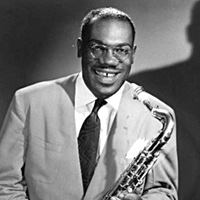Home » Jazz Musicians » Bull Moose Jackson
Bull Moose Jackson
Bull Moose Jackson's hit records in the 40's and ‘50’s were such lively, good-natured, toe-tappin' tunes that today, over 60 years later, they still draw new fans to the field of Rhythm & Blues. An originator of the Honkers and Shouters era, he was lucky enough to have benefited from a triumphant comeback in his career and enjoy first hand the effect of his music on a new generation of aficionados.
Born in Cleveland in 1919, Benjamin Clarence Jackson took up the saxophone instead of the violin that his parents wanted him to play. He started his first band, The Harlem Hotshots, while he was still in high school, with his friend Freddie Webster. Returning to Cleveland in 1943 after a brief stint in Buffalo, Jackson caught the eye of bandleader Lucky Millinder. It was the musicians in Millinder's band that gave him the unforgettable name "Bull Moose." One night while on tour in Texas, the scheduled singer Wynonie Harris didn't show up to sing. Jackson was pulled out of the sax section to croon the song "Hurry, Hurry," and a new career was born.
Syd Nathan had an interest in the Lucky Millinder Orchestra. Nathan was interested in expanding his small country & western label, King Records, and the newly developing form of music called Rhythm & Blues intrigued him. Millinder, already signed to Decca Records, encouraged his sax player/vocalist to record for Nathan. Bull Moose Jackson never looked back.
Over the next five years, Jackson recorded every style of popular music. In 1947, his recording of "I Love You, Yes I Do" became the first rhythm & blues single to sell a million copies. He followed this milestone with a continuous string of hits including "I Want a Bowlegged Woman," "Nosey Joe," and perhaps his best known song, "Big Ten Inch Record," and forever left his mark on the history of R&B.
Moose toured and recorded with his band "The Buffalo Bearcats" throughout the late `40s and early `50s, and in 1961 he re-recorded "I Love You, Yes I Do." Tired of the road and the expense of traveling, the early `60s found him limiting his performing to private engagements and working for a catering firm at Washington DC's Howard University. That's where Carl Grefenstette found him in 1983.
Grefenstette's band, The Flashcats, were a popular R&B act around Pittsburgh and tri-state (PA, OH, and WV) area. They routinely played several of Bull Moose's songs in their act. "We did 'Big Ten Inch' and we'd always introduce it as a Bull Moose Jackson record," Grefenstette recalls. "A lot of the people in the audience probably thought we were making the name up." But one person didn't. In the audience one evening was Howard Kozy (aka Bumblebee Slim), a local R&B disc jockey, who not only knew who Jackson was, but where.
Read moreTags
Bull Moose Jackson: Jazz Jump

Source:
JazzWax by Marc Myers
A careful look at a jazz discography always yields an interesting historical story. Back in the late 1940s, many jazz artists had their start in R&B and jump blues bands. The groups were often smartly organized jazz-blues hybrids that played tightly arranged charts and regularly toured, ensuring they'd be well-oiled recording artists. Bull Moose Jackson led one of those bands. A veteran of the Lucky Millinder Orchestra in the mid 1940s, Jackson formed his own band in 1947. A glance ...
read more






















